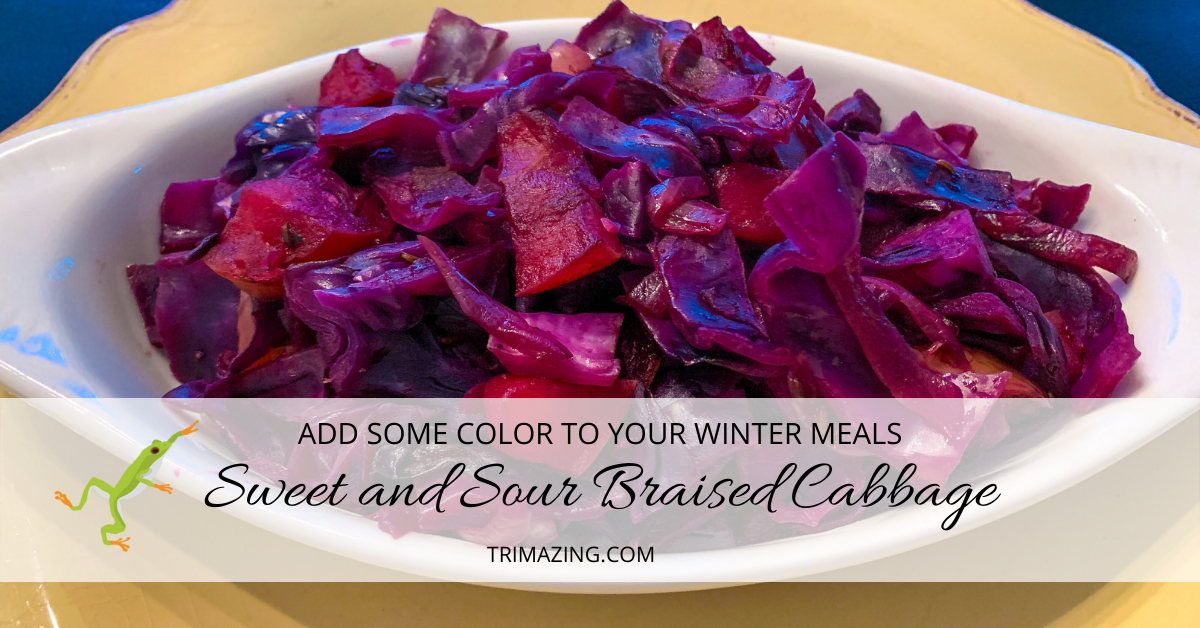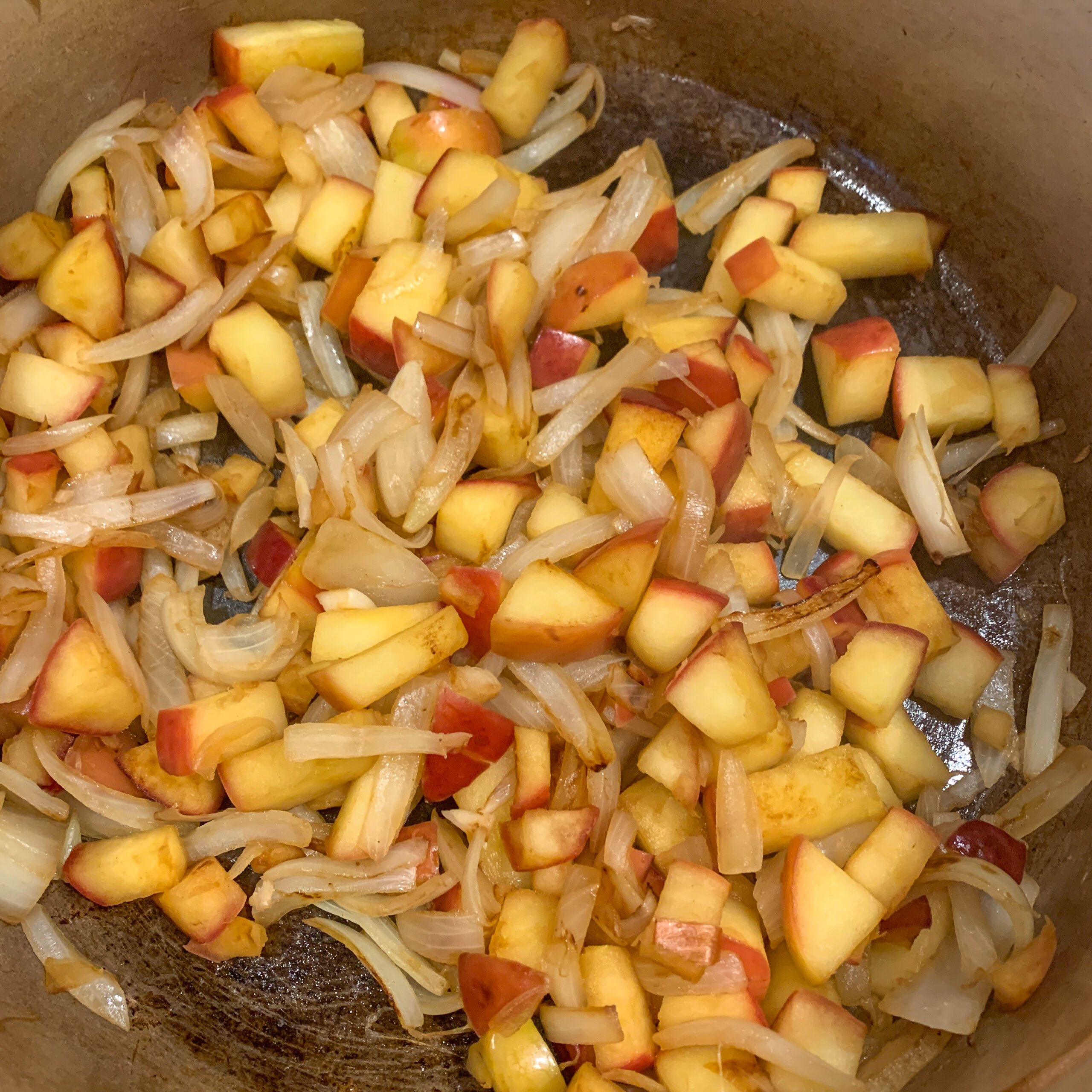Ingredient Spotlight: Cabbage + Sweet & Sour Braised Cabbage Recipe

Ingredient Spotlight: Cabbage
Such an underutilized vegetable, cabbage is a powerhouse ingredient!
Cabbages are part of the cruciferous vegetable family which includes broccoli, cauliflower, kale, radishes, kohlrabi, wasabi, etc. They are rich in glucosinolates, potent cancer-preventing phytonutrients that give cruciferous vegetables their pungent flavor and give off hydrogen sulfide (the culprit of that rotten egg smell when overcooked). Red cabbage and other red cruciferous vegetables are high in the immunity-boosting, anti-inflammatory antioxidant, anthocyanin.
Hack and Hold for Cooking

Cut cruciferous vegetables and wait 40 minutes before cooking. Photo by Cindy Thompson, Trimazing.com.
Interestingly, the health benefits of cruciferous vegetables are greatly enhanced if you eat them raw or cut and let rest before cooking. Cooking interrupts an important enzymatic process. Hack and Hold (cut and then rest) cruciferous veggies at least 40 minutes before cooking! This allows time for an enzyme, myrosinase, to combine with glucorophanin to create a potent antioxidant, sulforaphane. You may remember a similar technique used with members of the allium family (onions, garlic, leeks, etc.), which have a 10 minute hack and hold time.
Note, if you eat cruciferous vegetables raw, you don’t have to wait 40 minutes, you can eat them right after cutting, as this enzymatic process will occur in your stomach—cooking is the major interrupter.
Varieties
There are several types of cabbages. Here are varieties you may find at your market:
Green or White

Green or White Cabbage. Photo from Canva.
This hearty cabbage is a mainstay in coleslaw, but is also wonderful cooked. Green cabbage is often used to make sauerkraut.
Red or Purple

Red or Purple Cabbage. Photo from Canva.
Full of anthocyanins, red cabbage is a wonderful addition to raw salads and slaws. It is very sweet and makes a great raw snack. Add it to stir-fries or pasta dishes for a punch of color and antioxidants. Adding some acidity, such as citrus juice or vinegar, keeps red cabbage vibrant, preventing the purple color from bleeding out during cooking.
Savoy Cabbage

Savoy Cabbage. Photo from Canva.
A crinkly-lacy green cabbage originated from France. It’s milder than white/green cabbage and the outer leaves are softer than that variety. Use as you would green cabbage, but it’s also gorgeous stuffed, due to its texture.
Brussels Sprouts

Brussels Sprouts on the Stalk. Photo by Cindy Thompson, Trimazing.com.
Miniature green cabbages that grow on a stalk! Brussels sprouts can be a little more pungent than red or green cabbage. Remove from the stalk and roast or steam these bad boys. Or, thinly shave and quickly saute for a wonderful side dish. You can also eat these raw, shaved in a salad. By the way, if you buy Brussels sprouts on the stalk, cook the stalk to glean even more cruciferous-goodness!
Napa or Chinese

Napa or Chinese Cabbage. Photo from Canva.
Napa cabbage has a softer leaf, juicy stem, and mild flavor that some find easier to eat raw than green or red cabbage. It’s wonderful thinly shaved and tossed with rice vinegar and sesame seeds for a quick, light Asian-style slaw. Include ribbons of Napa cabbage in your stir-fry, adding it toward the end as cooks down quickly.
Bok Choy & Pak Choy

Bok Choy and Pak Choy. Image by Cindy Thompson, Trimazing.com.
Very tender, very mild, bok choy and pak choy are excellent additions to stir-fries. Slice these into wide ribbons, from leaf tip to root end and separate the leaf from the stalk for cooking. Add the stem pieces with other similarly textured vegetables, like onions, but wait until the end to add the sliced leaves, as they are very tender and cook quickly. It’s also wonderful raw.
Mustard Cabbage (Gai Choy)

Mustard Cabbage. Photo from Canva.
You may sometimes see this in grocery stores, but definitely in Asian markets. Mustard cabbage has a stronger flavor than bok or pak choy, but you use them just the same. I love it in stir-fries. If you find it too strong, combine with the milder Asian cabbages or quickly blanch before using.
Shopping
For round cabbages, choose heads that are heavy for their size, with shiny, tight leaves that are not yellowed, darkened, or have worm holes. Outer leaves may be a little wilted, but inner leaves should be shiny and tight. This is especially true for Brussels sprouts, as any bit of yellowing makes for a very bitter sprout! A trick for picking out cabbage is to rub two heads together and if they squeak, they’re fresh! Cabbages picked after frost will be sweeter.
Select Asian cabbages with firm white/light stalks without cracks or yellow/brown marks. Leaves should be dark and crisp.
Storage
Round cabbage heads store for a long time in the refrigerator. Keep them loose in your crisper drawer and peel off outer leaves if they start wilting. They are sweeter and most flavorful if used within a week, but they will keep much longer than that.
Store Asian cabbages unwashed in a perforated plastic bag for 3-4 days. You can also store in a cloth bag up to a week.
Sweet & Sour Braised Cabbage
I love this dish! My mom made this all throughout my childhood and braised cabbage just makes me happy. While I most often make this with purple (red) cabbage because I just love the color and extra antioxidants, you can use white/green, savoy, or Napa cabbage for this as well. This dish is only mildly sour, as the vinegar is added to keep the purple cabbage vibrant. If you’d like a more pronounced sourness, add more vinegar to your liking.
Ingredients

Simple ingredients, a cabbage, two apples, and an onion! Photo by Cindy Thompson, Trimazing.com.
This is so simple, just cabbage, apples, an onion, apple cider vinegar, caraway seeds, and salt and pepper—probably things you have in your refrigerator and pantry already! Use any color cabbage, onions, or apple. Today I used red cabbage, yellow onion, and Cosmic Crisp apples, but you can use green cabbage, savoy, Napa, red onions, Granny Smith or any other variety of apple.
Directions
The first step is to prepare your mise en place, that is chop all of your vegetables and measure out the ingredients. Chop your cabbage first, then your onions, then the apples—this will help reach the hack and hold time for the cabbage (40 minutes) and onions (10 minutes) to develop their beneficial antioxidants before cooking.

Hack and hold the cabbage and onions. Photo by Cindy Thompson, Trimazing.com.
Use a lidded pan or pot large enough to hold all of your ingredients. Heat over medium-high heat. Do NOT add any liquid or oil—you’re going to braise the vegetables and fruit in their own juices, which makes them super sweet.
Add the onions and apples first. Sauté until they start to brown and the onions soften, about 5-6 minutes.

Sauté until onions and apples are browned. Photo by Cindy Thompson, Trimazing.com.
Add the cabbage, apple cider vinegar, and caraway seed and stir. The acid of the apple cider vinegar prevents the color from leaching from the cabbage, keeping it vibrant. You could also use any other vinegar or lemon juice. Put on the lid, turn heat to low, and let braise for 20-25 minutes, stirring occasionally.

Add cabbage, caraway, and vinegar and then braise 20-25 minutes. Photo by Cindy Thompson, Trimazing.com.
I like mine tender-crisp, but you can cook longer until very soft. Do note that the cabbage will release hydrogen sulfide as it cooks to a completely softened state, so if you want to avoid that rotten egg smell, cook to tender-crisp. Season with salt and pepper, if desired and serve.

Finished braise. The apples turn into gorgeous jewels in the red cabbage! Photo by Cindy Thompson, Trimazing.com.
This is a great side dish. I really love to serve it with roasted or mashed winter squash. The flavors and colors of the purple cabbage and yellow winter squash really complement each other. And it’s one of my favorite things to eat for breakfast, hot or cold!
Enjoy!

Sweet & Sour Braised Cabbage
Ingredients
- 1 head red cabbage medium size, can use green as well, cut into eighths, cored, and sliced into ½-inch thick ribbons
- 2 apples unpeeled, cut into ½-inch dice
- 1 onion quartered and thinly sliced
- ¼ cup apple cider vinegar
- 1 tsp caraway seed
- salt and pepper to taste
Instructions
- Heat a Dutch oven or large sauté pan over medium-high heat. When hot, add chopped apples and sliced onions to dry, hot pot. Cook 5-6 minutes, stirring occasionally, until onions and apples start to brown and onion softens. Do NOT add any liquid or oil to this.
- Add sliced cabbage, caraway seed, and apple cider vinegar and stir to combine. Reduce heat to low, cover, and cook 20-25 minutes, stirring occasionally, until cabbage is tender. I like mine tender-crisp, but you can cook down until completely tender, if desired. Season with salt and pepper and serve.
Nutrition
Do you like this post? Please share....
[mashshare]
If you liked this post, you might like one of these:
Categories:

[Trī-māz-ing]
Cindy wants you to be Trimazing—three times better than amazing! After improving her health and fitness through plant-based nutrition, losing 60 pounds and becoming an adult-onset athlete, she retired from her 20-year firefighting career to help people just like you. She works with people and organizations so they can reach their health and wellness goals.
Cindy Thompson is a national board-certified Health and Wellness Coach, Lifestyle Medicine Coach, Master Vegan Lifestyle Coach and Educator, Fitness Nutrition Specialist, Behavior Change Specialist, and Fit2Thrive Firefighter Peer Fitness Trainer. She is a Food for Life Instructor with the Physicians Committee for Responsible Medicine, Rouxbe Plant-Based Professional, and Harvard Medical School Culinary Coach, teaching people how to prepare delicious, satisfying, and health-promoting meals.
She provides health and lifestyle coaching at Trimazing! Health & Lifestyle Coaching. Cindy can be reached at info@trimazing.com.
Subscribe to the Trimazing Blog
Receive occasional blog posts in your email inbox.
Subscribe to the Trimazing Blog
Receive occasional blog posts in your email inbox.





















